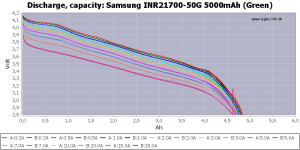Nuckingfuts
10 mW
- Joined
- Aug 7, 2022
- Messages
- 20
I may not have enough info to go on but I've got a 74V 55Ah battery for my Surron Ultra Bee. When it's 100% charged (according to the bike display and after charging) I get a voltmeter reading of 76.0VDC. As a second data point, when the battery is discharged to 45% I get a reading of 66.5VDC. This doesn't correlate with any of the 74V battery charts I can find. Do these values make sense to you? Is my charger only charging to a much lower percentage than indicated by display??
Searching which cells are used by Surron I get the A-grade Samsung Li-Ion INR 21700 cells, which appear to have a nominal voltage of 3.63V (LiMn ??) but I can't confirm if this is accurate. If this is indeed the case, then I would think this 74V pack should have a voltage north of 80V when charged to 100%???
I tried to study up on the basics but I'm still learning so any help to understand is appreciated.
Searching which cells are used by Surron I get the A-grade Samsung Li-Ion INR 21700 cells, which appear to have a nominal voltage of 3.63V (LiMn ??) but I can't confirm if this is accurate. If this is indeed the case, then I would think this 74V pack should have a voltage north of 80V when charged to 100%???
I tried to study up on the basics but I'm still learning so any help to understand is appreciated.
Last edited:


